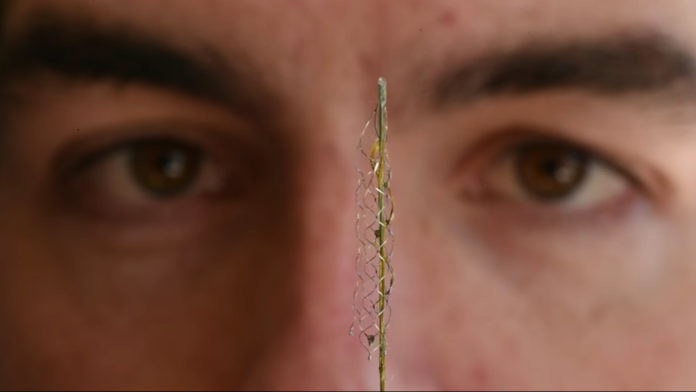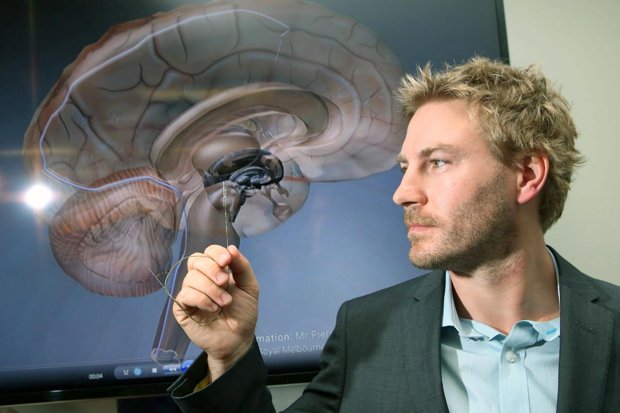
[responsivevoice voice=”UK English Female” buttontext=”Play”]
Scientists at the University of Melbourne have built a tiny device just 3 centimeters long and a few millimeters wide that could help paralyzed patients walk again. Through the power of subconscious thought, the patient without resorting to open brain surgery, could be mobile.
Co-principal investigator and biomedical engineer at the University of Melbourne, Dr Nicholas Opie, explained that the concept was similar to an implantable cardiac pacemaker.
“Utilizing stent technology, our electrode array self-expands to stick to the inside wall of a vein, enabling us to record local brain activity. By extracting the recorded neural signals, we can use these as commands to control wheelchairs, exoskeletons, prosthetic limbs or computers.
“In our first-in-human trial, that we anticipate will begin within two years, we are hoping to achieve direct brain control of an exoskeleton for three people with paralysis. Currently, exoskeletons are controlled by manual manipulation of a joystick to switch between the various elements of walking — stand, start, stop, turn. The stentrode will be the first device that enables direct thought control of these devices.”
Bionic SpineThis bionic spine could help paralyzed patients walk again.
Posted by Hashem Al-Ghaili on Tuesday, February 9, 2016
The paperclip-sized bionic spine, which contains 12 stent-based electrodes, is implanted in the brain’s motor cortex via a catheter in the neck and pushed up to the cortex. Once the bionic spine is implanted, the electrodes on its exterior will stick to the walls of a vein and start recording electrical signals from the motor cortex. These signals are then transmitted to another device implanted in the patient’s shoulder, which translates them into commands to control wheelchairs, exoskeletons, prosthetic limbs, or computers.
The first steps towards a bionic spine? https://t.co/jHnMWrz3XD @scalzi did you see this? pic.twitter.com/b5SXaeApic
— Jennie Rosenbaum (@minxdragon) February 9, 2016
Neurologist and lead researcher at the Royal Melbourne Hospital and the University of Melbourne, Thomas Oxley, added:
“We have been able to create the world’s only minimally invasive device that is implanted into a blood vessel in the brain via a simple day procedure, avoiding the need for high risk open brain surgery. Our vision, through this device, is to return function and mobility to patients with complete paralysis by recording brain activity and converting the acquired signals into electrical commands, which in turn would lead to movement of the limbs through a mobility assist device like an exoskeleton. In essence this a bionic spinal cord.”
Prof. Terry O’Brien, the head of medicine in the Royal Melbourne hospital’s neurology department, told The Guardian the development of the bionic spine was the “holy grail” for bionics researchers – it would not repair damaged pathways in the brain, but would help the brain find new ways of doing things.
“For example if I want to pick up a phone, but my hand is paralyzed, I can use my other hand to pick up the phone instead. You have a normal way to use the brain to pick up the phone, but if that doesn’t work, you find another way. Your brain learns another function can be harnessed to do what you’ve lost. What the stent is doing is putting a recorder over the signals in the brain and providing then a conduit to move the limb via those signals bypassing the damaged area.”
With two of the pioneering engineers developing the world first #BionicSpine in Melbourne. Huge win for @TheRMH pic.twitter.com/Pbn2T5US9l
— Robert Doyle (@LordMayorMelb) February 9, 2016
The procedure, which has been trialed on sheep, is expected to be commercially available by the mid-2020s.
This article (World’s First Bionic Spinal Cord could help Paralyzed Walk again using Power of Thought) is a free and open source. You have permission to republish this article under a Creative Commons license with attribution to the author and AnonHQ.com.
[/responsivevoice]





